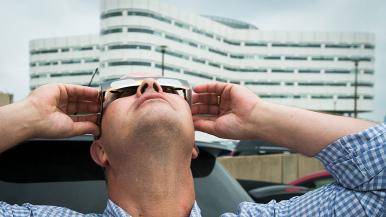Got plans for Monday, April 8? You know — the day when a total solar eclipse will cross over North America?
A total solar eclipse is when the moon completely covers the sun. And this one will last for about four minutes and 28 seconds, making it one of the longest total solar eclipses of this century.
The 2024 eclipse will also create a wider path of totality — which is the moon’s shadow across the Earth’s surface — than in 2017.
In order to view it, you must be within the eclipse’s 115-mile wide path. If you live outside of the path, you’ll be able to view a partial eclipse.
Protecting your eyes
But before you step outside on Monday, you need to take precautions to protect your eyes.
Without safety measures, viewing the eclipse can damage them by creating a burn in the retina, which is the back of the eye. Exposure to the light can damage cells in the retina, RUSH ophthalmologist Nina Goyal, MD, FACS, told NBC Chicago.
Ideally that means wearing ISO 12312-2 certified glasses, Goyal says.
“There is no safe ‘direct way’ to view the eclipse without ISO 12312-2 certified glasses,” Goyal says. “The only safe way to view without glasses is indirectly, using a ‘pinhole projector box’ or a colander for example, but always with your back to the sun.”
Wear the right glasses
How can you tell if those glasses are certified?
“Cross check the brand with the American Astronomical Society’s website to make sure it’s a reputable manufacturer — and not counterfeit,” she says.
If someone looks at the eclipse with no protective eyewear, they should see an ophthalmologist for a dilated retinal exam with OCT imaging.
“We would need a repeat exam a few days later after the initial visit, as it can take days for the macular burn to manifest itself,” Goyal says.
So be sure to have your glasses ready for Monday, because it’s the only way to safely watch this eclipse. And you won’t get another opportunity for a total solar eclipse in the United States until August 2044.




